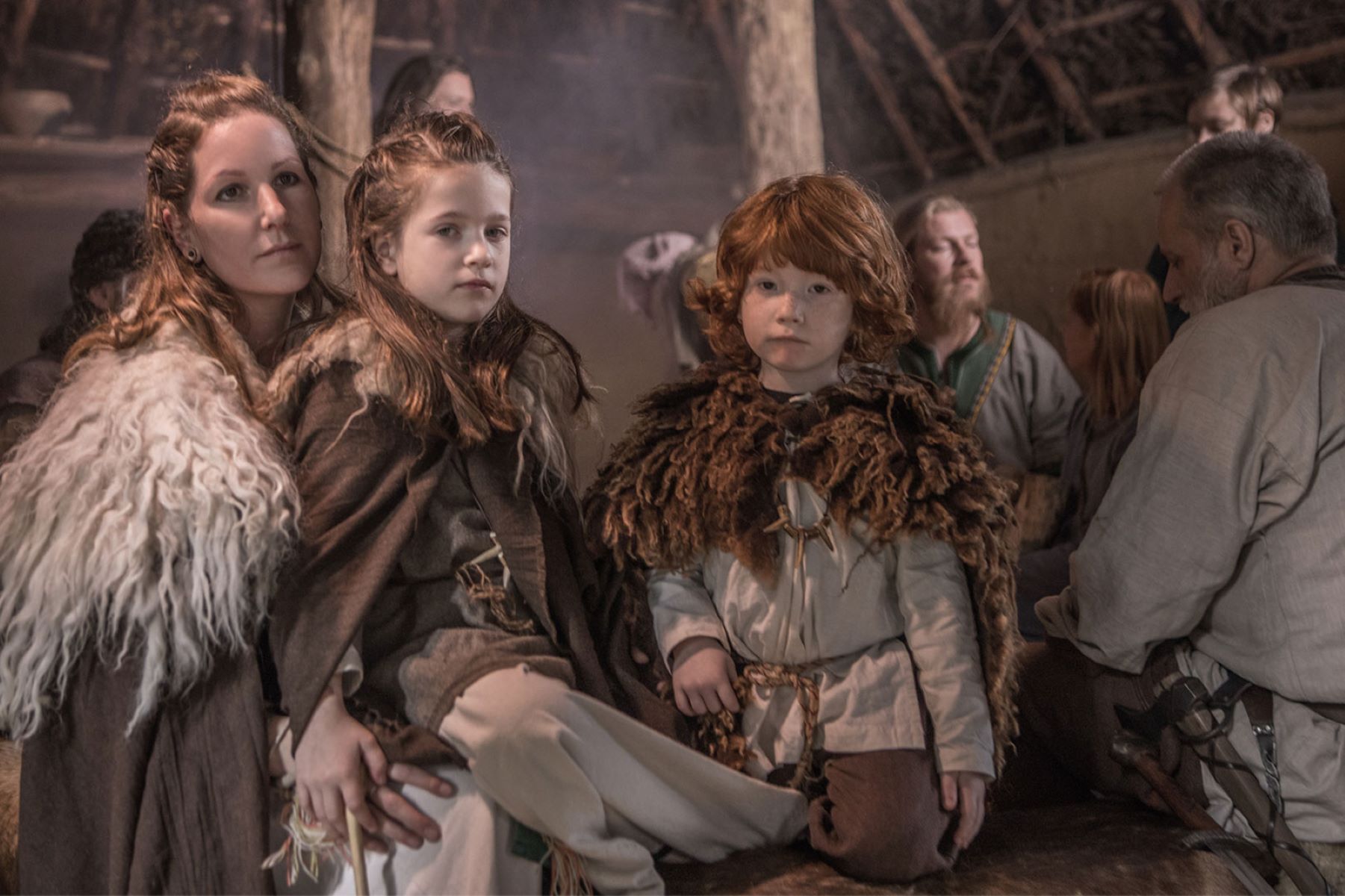Home>History>Vikings: Did They Have Surnames Or Were They Known By Just Their First Names? Find Out The Fascinating Origins Of Viking Surnames!


History
Vikings: Did They Have Surnames Or Were They Known By Just Their First Names? Find Out The Fascinating Origins Of Viking Surnames!
Published: January 7, 2024
Uncover the intriguing origins of Viking surnames and discover whether they had surnames or were known by just their first names. Delve into the history of Vikings and their naming conventions.
(Many of the links in this article redirect to a specific reviewed product. Your purchase of these products through affiliate links helps to generate commission for Regretless.com, at no extra cost. Learn more)
Table of Contents
Introduction
The Vikings, famed for their seafaring prowess and formidable conquests, continue to captivate the imagination with their rich and enigmatic history. One intriguing aspect of Viking culture is their naming system, which offers a glimpse into their social structure, traditions, and the evolution of surnames. While many may wonder whether Vikings had surnames or were known solely by their first names, delving into the origins and development of Viking surnames unveils a fascinating narrative that sheds light on their intricate society.
The exploration of Viking surnames provides a gateway to understanding the complexities of Viking identity and the significance of names within their culture. By unraveling the historical context and linguistic influences that shaped Viking naming practices, we can gain valuable insights into the customs and beliefs that defined this legendary civilization. Join us on a captivating journey through the annals of Viking history as we uncover the compelling origins and evolution of Viking surnames, illuminating a lesser-known aspect of this remarkable ancient culture.
The Viking Naming System
The Viking naming system was deeply rooted in the societal structure and cultural traditions of the Norse people. Understanding the intricacies of their naming practices provides valuable insights into the social dynamics and individual identities within Viking society. The naming conventions of the Vikings were characterized by a distinctive combination of elements, reflecting their heritage, familial ties, and geographical origins.
Patronymic Naming
At the core of the Viking naming system was the use of patronymic surnames, wherein an individual's last name was derived from their father's first name. For instance, if a man named Erik had a son named Leif, the son's surname would be Leif Eriksson, indicating that he was the son of Erik. This practice extended to daughters as well, with the addition of the suffix "dottir" to denote "daughter." Therefore, a daughter of Erik would be known as Anna Eriksdottir. This patronymic naming convention served as a fundamental aspect of Viking identity, emphasizing lineage and familial connections.
Descriptive and Occupational Elements
In addition to patronymic surnames, Vikings also incorporated descriptive or occupational elements into their names. These descriptors often conveyed physical attributes, personal characteristics, or professions, further distinguishing individuals within the community. For example, a Viking might be known as "Erik the Red," highlighting a prominent physical feature or possibly a noteworthy achievement. This practice contributed to the multifaceted nature of Viking names, offering nuanced insights into an individual's identity beyond familial ties.
Geographical Influences
The geographical origins of the Vikings also played a significant role in their naming conventions. Individuals were often identified by the name of their homestead or the specific region they hailed from, adding another layer of distinction to their names. This geographical element not only provided context regarding an individual's place of origin but also contributed to the diversity of Viking surnames, reflecting the varied landscapes and settlements across the Norse territories.
Cultural Significance
The Viking naming system was more than a mere means of identification; it embodied the cultural values and interconnectedness of the Norse people. Names served as a link to ancestral heritage, reinforcing familial bonds and preserving the legacy of previous generations. Furthermore, the dynamic nature of Viking names reflected the fluidity of identity within their society, encompassing a spectrum of personal, familial, and regional associations.
Intricately woven into the fabric of Viking society, the naming system epitomized the complexities of Norse culture, offering a window into the individuality, heritage, and interconnectedness that defined the Viking people. This distinctive naming tradition continues to intrigue and inspire, encapsulating the enduring legacy of the legendary Norse civilization.
Origins of Viking Surnames
The origins of Viking surnames are deeply rooted in the cultural, linguistic, and societal dynamics of the Norse people. The evolution of Viking surnames can be traced back to the intricate web of traditions, influences, and historical developments that shaped the naming practices of this legendary civilization. Understanding the origins of Viking surnames unveils a captivating narrative that reflects the complexities of Norse identity and the enduring legacy of their naming conventions.
The fundamental cornerstone of Viking surnames lies in the patronymic tradition, wherein an individual's last name is derived from their father's first name. This practice not only served as a means of identification but also underscored the significance of familial lineage and kinship ties within Viking society. The patronymic element of Viking surnames exemplifies the deeply ingrained emphasis on familial connections and ancestral heritage, reflecting the cultural values and social structure of the Norse people.
In addition to patronymic surnames, the descriptive and occupational elements incorporated into Viking names further enrich the origins of Viking surnames. These descriptors, often highlighting physical attributes, personal characteristics, or professions, contributed to the multifaceted nature of Viking identities. Whether it was "Erik the Red" or "Ragnar the Fearless," these descriptive components added depth and distinction to Viking surnames, reflecting individual traits and achievements within the community.
Furthermore, the geographical influences on Viking surnames underscore the diverse origins and regional affiliations of the Norse people. Names derived from homesteads, specific locations, or geographical features not only provided insights into an individual's place of origin but also showcased the rich tapestry of landscapes and settlements across the Norse territories. This geographical layer of Viking surnames encapsulated the varied environments and cultural nuances within the Viking world, further enriching the diversity of their naming practices.
The origins of Viking surnames are intertwined with the cultural significance and historical intricacies of Norse society, embodying the enduring legacy of a civilization that continues to captivate and inspire. By delving into the origins of Viking surnames, we unravel a profound tapestry of traditions, familial bonds, and regional identities that exemplify the depth and complexity of Viking culture.
Evolution of Viking Surnames
The evolution of Viking surnames reflects a remarkable journey shaped by historical developments, cultural exchanges, and linguistic transformations. As the Viking Age unfolded, the naming practices of the Norse people underwent a dynamic evolution, influenced by a myriad of factors that contributed to the diversification and refinement of Viking surnames.
The early stages of Viking surnames were characterized by the predominant use of patronymic elements, where individuals were identified by their father's first name followed by the suffixes "son" or "dottir." This patronymic tradition, deeply ingrained in Norse society, served as a foundational aspect of Viking identity, emphasizing familial lineage and generational ties. However, as the Viking world encountered new cultures and territories through exploration and conquests, the naming landscape began to undergo significant shifts.
The intermingling of Norse, Anglo-Saxon, and Celtic influences during the Viking expansion across Europe brought about a fusion of naming customs, leading to the incorporation of additional elements into Viking surnames. Descriptive and occupational components became more prevalent, contributing to the richness and diversity of Viking identities. These descriptive elements, often derived from physical attributes, personal characteristics, or notable accomplishments, added layers of nuance to Viking surnames, reflecting individual traits and achievements within the community.
Furthermore, the geographical influences on Viking surnames expanded as the Norse territories expanded and interactions with diverse cultures intensified. Names derived from specific regions, homesteads, or geographical features became more pronounced, reflecting the varied origins and affiliations of the Norse people. This geographical evolution of Viking surnames not only provided insights into individuals' places of origin but also showcased the intricate tapestry of landscapes and settlements across the Viking world, underscoring the cultural diversity within their society.
The evolution of Viking surnames mirrors the dynamic interactions and cultural exchanges that defined the Viking Age. The fusion of patronymic, descriptive, occupational, and geographical elements contributed to the multifaceted nature of Viking identities, reflecting the complexities of Norse society and the enduring legacy of their naming traditions. This evolution underscores the adaptability and resilience of Viking naming practices, illustrating the capacity of names to encapsulate the ever-changing dynamics of a civilization that left an indelible mark on history.
Examples of Viking Surnames
The rich tapestry of Viking surnames offers a compelling glimpse into the diverse and evocative identities that characterized Norse society. These names, often rooted in patronymic, descriptive, occupational, and geographical elements, encapsulate the multifaceted nature of Viking identities. Here are a few illustrative examples of Viking surnames that showcase the depth and complexity of Norse naming practices:
-
Eriksson and Eriksdottir: Derived from the first name Erik, these patronymic surnames exemplify the foundational naming tradition of the Vikings. By denoting "son of Erik" and "daughter of Erik" respectively, these surnames underscore the emphasis on familial lineage and generational connections within Viking society.
-
Thorsteinsson: Reflecting the influence of Norse mythology, this patronymic surname signifies "son of Thorstein," invoking the revered deity Thor. The incorporation of mythological elements into Viking surnames highlights the cultural and spiritual significance embedded in their naming practices.
-
Ragnarsdottir: Bearing the suffix "dottir," this patronymic surname signifies "daughter of Ragnar," emphasizing the lineage and familial ties of individuals within the Viking community. The prevalence of matronymic elements further enriches the spectrum of Viking surnames, showcasing the significance of both paternal and maternal lineages.
-
Haraldsson the Black: This example illustrates the incorporation of descriptive elements into Viking surnames, with the epithet "the Black" possibly alluding to a physical attribute, a notable achievement, or a distinct characteristic associated with an individual. Descriptive components added depth and distinction to Viking names, reflecting unique traits and accomplishments.
-
Leif the Fisher: Combining an occupational descriptor with a personal name, this surname highlights the practice of incorporating professions or activities into Viking identities. The designation "the Fisher" offers insights into the individual's occupation, further illustrating the nuanced nature of Viking surnames.
-
Gunnarsson from Hedeby: This example exemplifies the geographical influences on Viking surnames, as it combines the patronymic element "sson" with the indication of a specific location, Hedeby. Geographical descriptors not only provided insights into individuals' places of origin but also showcased the diverse landscapes and settlements within the Viking world.
These examples represent a fraction of the diverse and evocative Viking surnames that reflect the intricate tapestry of Norse culture. Through patronymic, descriptive, occupational, and geographical elements, these surnames encapsulate the multifaceted identities and rich heritage of the Viking people, offering a compelling testament to the enduring legacy of their naming traditions.
Conclusion
The exploration of Viking surnames unveils a captivating narrative that reflects the complexities of Norse identity and the enduring legacy of their naming conventions. The Viking naming system, characterized by patronymic, descriptive, occupational, and geographical elements, offers valuable insights into the social dynamics, cultural values, and individual identities within Viking society. The origins of Viking surnames are deeply rooted in the cultural, linguistic, and societal dynamics of the Norse people, embodying the enduring legacy of a civilization that continues to captivate and inspire.
The evolution of Viking surnames mirrors the dynamic interactions and cultural exchanges that defined the Viking Age. The fusion of patronymic, descriptive, occupational, and geographical elements contributed to the multifaceted nature of Viking identities, reflecting the complexities of Norse society and the enduring legacy of their naming traditions. This evolution underscores the adaptability and resilience of Viking naming practices, illustrating the capacity of names to encapsulate the ever-changing dynamics of a civilization that left an indelible mark on history.
These examples represent a fraction of the diverse and evocative Viking surnames that reflect the intricate tapestry of Norse culture. Through patronymic, descriptive, occupational, and geographical elements, these surnames encapsulate the multifaceted identities and rich heritage of the Viking people, offering a compelling testament to the enduring legacy of their naming traditions.
In conclusion, the exploration of Viking surnames provides a gateway to understanding the complexities of Viking identity and the significance of names within their culture. By unraveling the historical context and linguistic influences that shaped Viking naming practices, we gain valuable insights into the customs and beliefs that defined this legendary civilization. The study of Viking surnames not only enriches our understanding of Norse history but also serves as a testament to the enduring legacy of a civilization that continues to captivate and inspire.



